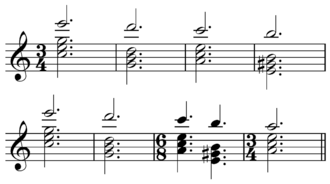Romanesca

Romanesca was a melodic-harmonic formula popular from the mid 16th to early 17th centuries, used as an aria formula for singing poetry and as a subject for instrumental variation. It was most popular with Italian composers of the early Baroque period. It was also used by vihuelistas including Luis de Narváez, Alonso Mudarra, Enríquez de Valderrábano, and Diego Pisador.[1]
Originating in Spain as O guárdame las vacas ("O let us put the cows to pasture" or, "look after the cows for me",[1] occasionally known as Seculorum del primer tono in reference to the similarity between the a g f e d melody line and that of the chief termination, "Seculorum, Amen", of the first psalm tone),[2] a romanesca is composed of a sequence of four chords with a simple, repeating bass, which provide the groundwork for variations and improvisation. A famous example is the refrain of "Greensleeves" (whose verses follow the progression of the passamezzo antico, of which the romanesca is an alteration) ![]() Play . The romanesca is usually in triple meter and its soprano formula (melody) resembles that of the passamezzo antico but a third higher.[2]
The harmonic bass pattern of the romanesca is:
Play . The romanesca is usually in triple meter and its soprano formula (melody) resembles that of the passamezzo antico but a third higher.[2]
The harmonic bass pattern of the romanesca is:
Romanesca is also the name of two early music ensembles: one, La Romanesca, founded in 1978 in Australia by John Griffiths; and the other, Romanesca, founded in 1988 in England by Nigel North. Both specialize in the performance of early plucked string instruments.
See also
Sources
- 1 2 3 Turnbull, Harvey (1974). The Guitar from the Renaissance to the Present (New York: Charles Scribner's Sons), p. 31. Reprinted in Guitar Study Series GSS 1 (Westport, CT: Bold Strummer, 1991) ISBN 0-933224-57-5. See: "Archived copy" (PDF). Archived from the original (PDF) on June 12, 2007. Retrieved December 15, 2011..
- 1 2 3 Apel, Willi (1997). The History of Keyboard Music to 1700, p.263. Trans. Tischler, Hans. ISBN 0-253-21141-7.
Further reading
- Gerbino, Giuseppe. 2001. "Romanesca". The New Grove Dictionary of Music and Musicians, second edition, edited by Stanley Sadie and John Tyrrell. London: Macmillan Publishers.